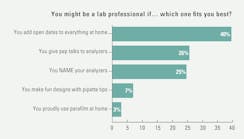The H1N1influenza
combined with the seasonal strain continues to capture the public's
attention, while manufacturers of the H1N1 vaccine struggle at the time
of this writing to keep a steady flow of product moving into
public-health venues. Lessons learned during this flu seasons have come
too late for many — primarily pregnant women and those victims with
other underlying complications. Information from government resources is
now updated, in some cases, multiple times during a 24-hour period.
1
Micro~Bytes from Hardy Diagnostics include
a dozen “flu facts,” among them: “The 2009 H1N1 influenza viral genome
is made up of genes from pigs, birds, and humans, the combination of
which has not been seen before, thus resulting in low immunity among the
general population.” Go to
www.rsleads.com/912ml-201 to sign up for the newsletter.
2
According to Abbott Molecular, “a promising
new technology — electrospray-ionization mass spectrometry, or
PCR/ESI-MS, was used to first detect the H1N1 virus in the USA earlier
this year.” Abbott Molecular filed for 510k approval for a PCR/ESI-MS
device in recent months. PCR/ESI-MS allows scientists to quickly find
and identify influenza strains no one has ever seen before. The
technology has enormous potential for biosurveillance, vaccine design,
and hundreds of other applications beyond influenza. Visit
www.rsleads.com/912ml-202 .
3
The U.S. Small Business Administration
distributes a “business preparedness guide” from the U.S. Department of
Homeland Security at
www.rsleads.com/912ml-203 . The guide was created to minimize
disruption during the flu season. Absenteeism is likely to be the
central issue for businesses to contend with during a pandemic, so
management should focus on reducing the transmission of the seasonal flu
and H1N1 in the workplace — including encouraging sick employees to stay
home, wiping down phones, door knobs, and computer keyboards with
disinfectant wipes on a weekly basis, as well as washing hands. Get the
guide for comprehensive information on planning for a flu outbreak at
POLs or laboratory offices.
4
The New York Times reported Oct.
27 the story of Aubrey Opdyke of West Palm Beach, FL, who came down with
H1N1 during her pregnancy in June. During a four-month hospitalization,
Opdyke spent five weeks in a coma, suffered six collapsed lungs, and had
a near-fatal seizure. She also lost her baby at 27 weeks. On Oct. 1, the
Centers for Disease Control and Prevention (CDC) said 100 pregnant women
had been in intensive care with H1N1 flu and 28 had died. Pregnant women
are in the age group most likely to catch the new virus, and their
immune systems are suppressed during pregnancy. Go to
www.rsleads.com/912ml-204 to read more.
5
Reader's Digest reported a
disturbing aspect of the new H1N1 flu: When it affects the lungs, it
does more damage than the typical seasonal flu. The same was true of the
strain that caused the Spanish flu of 1918-1919, which — in three waves
— swept the world killing approximately 50 million people, including
500,000 Americans. The virus responsible for the 1918 pandemic caused
only mild disease at first but evolved in ways that made it able to kill
previously healthy people. Put on a Snuggie, make some hot tea, and read
the article at
www.rsleads.com/912ml-205 .
6
On Nov. 8, Canwest News Service reported
that Ontario's former chief medical officer of health said there were
early signals H1N1 would be the dominant strain this flu season. He
acknowledged that a strain replacement (where a new virus replaces old
ones that had been circulating) is a classic characteristic of a
pandemic virus. “That is what happened in 1918, it is what happened in
1957, and it is what happened in 1968.” The article also notes that on
Nov. 6, the World Health Organization (WHO) reported that intense and
persistent flu spread continues to be reported in North America, without
evidence of a peak in activity. According to WHO, the proportion of
doctors visits due to flu-like illness has exceeded levels seen over the
past six flu seasons. Typically, flu infects about 10% of the population
each year. In the 1918 influenza pandemic, half the North American
population was infected. For further details, go to
www.rsleads.com/912ml-206 .
7
According to James Steckelberg, MD, an infectious
disease specialist at Mayo Clinic, the list of folks who need to get the H1N1
vaccination includes:
- Pregnant women.
- Household contacts and caregivers for children younger than 6 months.
- Healthcare and emergency medical services personnel.
- Babies from 6 months, and children and teens through 18 years old.
- Young adults, from 19 through 24 years.
- People ages 25 through 64 years who have health conditions associated with
higher risk of medical complications from influenza.
H1N1 has the same symptoms as seasonal influenza and bird flu, so there is no
way to know the specific influenza type except by testing. For other basic
information, go to
www.rsleads.com/912ml-207.
8
The hajj pilgrimage —this year from Nov.
25-30 — is required of all able-bodied Muslims at least once in their
lifetimes. It became a concern for world health officials because the
pilgrimage attracts about 3 million people from 160 countries annually —
with shoulder-to-shoulder contact as they pray. A conference in June
recommended that the elderly, pregnant women, people with chronic
diseases, and children skip the pilgrimage this year, with the Saudi
Arabian health minister suggesting that it was the responsibility of
individual countries to enforce the recommendations. He was the first
person in the country to receive the H1N1 vaccination in a Nov. 7
televised event aimed at encouraging pilgrims to get vaccinated prior to
the hajj. See
www.rsleads.com/912ml-208.
9
Reuters reported in early October
that a Harris poll revealed that 74% of U.S. adults say it is unlikely
they will contract H1N1 this year. Conversely, the CDC predicted that up
to 40% of Americans could be infected with H1N1 through 2010. The study
highlighted widespread confusion about the cause of the H1N1 virus and
the preventive methods associated with it. According to the CDC, the
virus can survive up to 72 hours on common surfaces, so good hygiene is
essential to minimize the spread of the virus. Fifty percent of U.S.
adults reported they were confident they could protect themselves from
contracting the virus. Yet, 38% say they would not be washing their
hands more frequently. Read more at
www.rsleads.com/912ml-209 .
10
At a Nov. 9 U.S. Department of Health and
Human Services news conference, the director of the National Institute
of Allergy and Infectious Disease announced that out of about 100
pregnant women who participated in trial studies, more than 90% showed
“a robust immune response to a single 15-microgram dose of the H1N1
vaccine” with no reported side effects.
CNN.com cited studies on children between 6 and 35 months, and
those 3 to 9 years showed they responded better to two 15-microgram
doses of H1N1 vaccine than a single dose.
CNN.com also quoted the director of the CDC's National Center
for Immunization and Respiratory Diseases as saying that the difference
between H1N1 virus and the seasonal flu was that the latter caused 90%
of the yearly deaths in people over 65, while 90% of the deaths so far
with H1N1 have been in people under 65. See
www.rsleads.com/912ml-210.
11
At a meeting of the Infectious Disease
Society of America, researchers announced that N95 respirators may not
protect better against H1N1 influenza than surgical face masks. The Food
and Drug Administration says the N95 respirator is designed to filter
out even very fine airborne particles, while surgical masks protect
against large-particle droplets, splahses, sprays, or splatter but do
not block germs from coughs and sneezes. The debate over which is best
appears moot since healthcare workers complain that the more expensive
respirators are uncomfortable, more difficult to wear than face masks,
and make conversing with patients difficult. The debate, opines the
president of the Society for Healthcare Epidemiology of America, has
distracted healthcare workers from other important flu-fighting measures
such as getting both seasonal and H1N1 vaccines. Get more details at
www.rsleads.com/912ml-211.
12
New York's Governor announced in late
October that the State Health Commissioner had suspended the mandatory
influenza immunization requirement for New York healthcare workers so
that the limited vaccine supplies could be used for populations most at
risk of serious illness and death. With vaccine supplies arriving in
smaller amounts and being delivered later than originally projected, not
all workers would be able to get vaccinated before the November 30
deadline provided in the regulation. The CDC originally projected 200
million doses of H1N1 vaccine would be available by end-November but
changed its estimate to 65.9 million doses when manufacturers had
difficulty making the antigen, or active ingredient, used in the H1N1
vaccine. Another factor behind the H1N1 delay was the problem in
finishing up production for the seasonal vaccine. Learn more at
www.rsleads.com/912ml-212 and
www.rsleads.com/912ml-213.





